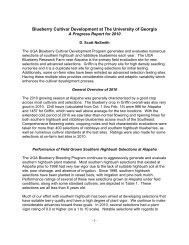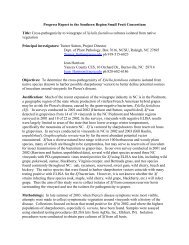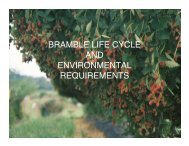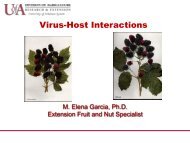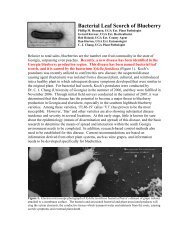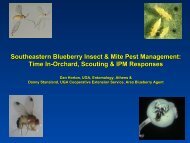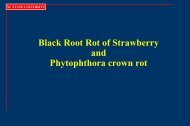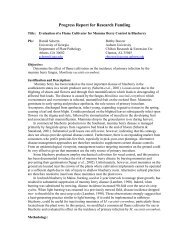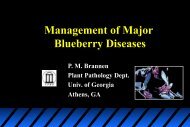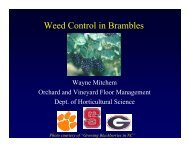Southeast Regional Blueberry Horticulture and Growth Regulator ...
Southeast Regional Blueberry Horticulture and Growth Regulator ...
Southeast Regional Blueberry Horticulture and Growth Regulator ...
Create successful ePaper yourself
Turn your PDF publications into a flip-book with our unique Google optimized e-Paper software.
Avoid drift. Dormex may be toxic to green plants such as winter vegetable crops <strong>and</strong> shrubs; it is also toxic to pets, wild animals <strong>and</strong> livestock. Usea spray pressure of 50 psi to reduce drift.Flower buds sprayed at stage three or beyond may be killed by Dormex, especially at concentrations of 1.5% to 2%. However, when applied in thecorrect “window” of bud development (bud stage 1 <strong>and</strong> 2), 1.5% to 2% usually gives a much better response than 1%.Direct spray nozzles to the area with flower buds.Do not apply within 14 days of an oil spray or within 30 days of a copper fungicide spray.Apply during dry weather. Slow drying may enhance Dormex activity <strong>and</strong> cause more phytotoxicity if the buds are swelling.Dormex may advance flowering by several days, slightly increasing the risk of freeze damage.Dormex is not needed on cultivars with good leaf development such as ‘Sharpblue’, ‘Emerald’ <strong>and</strong> ‘Brightwell’. Dormex reponse has been erratic on‘O’Neal’.Do not apply to cultivars with “puffy” flower buds such as ‘Sharpblue’. Dormex may wick between the bud scales <strong>and</strong> kill even dormant flowerbuds.Gibberellic Acid as an Aid for Fruit Set of Rabbiteye BlueberriesAdditional considerations <strong>and</strong> precautions for using Gibberellic Acid:1. Gibberellic acid is expensive, but has been effective in improving fruit set on bushes affected by poor pollination. Poor pollination can be theresult of cultivars not blooming together, cultivars which have low pollen compatibility, low bee activity, high night temperatures during bloom, lowtemperatures during bloom, excessively rainy weather during bloom, <strong>and</strong> damage to the blooms from insects such as thrips. Many large fields insouth Georgia will benefit from gibberellic acid application in most years.2. Good results can be obtained with two applications of 24-32 oz./acre (48-64 oz./acre total) in 40 gallons of water per acre, spraying both sides ofthe bush each time. Another successful method is cultivar directed treatment (CDT). Where two varieties with different bloom dates are plantedtogether (i.e. 'Climax' with 'Tifblue') this is the best method. Using CDT, the first <strong>and</strong> second application of gibberellic acid are directed toward thefirst variety to bloom (i.e. ‘Woodard’ or ‘Climax’). Some gibberellic acid will also reach the adjacent variety (i.e. ‘Tifblue’), helping the early





